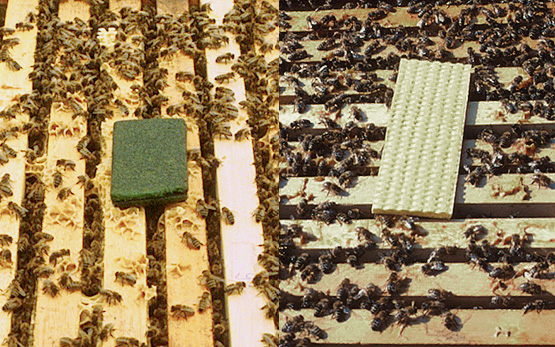Jeker L., Grossar D., Straub L.
Unterschätzte Schadwirkung von Nematoden auf Bienen.
Beiheft Schweizerische Bienenzeitung, 4, 2024, 26-28.
Rüfenacht A., Straub L., Grossar D., Jeker L.
Underestimated adverse effects of entomopathogenic nematodes to honey bees.
In: AG-Bienentagung. 30. March, Potsdam. 2023, 1.
Rüfenacht A., Straub L., Grossar D., Jeker L.
Underestimated adverse effects of entomopathogenic nematodes on honey bees.
In: SETAC Europe Society of Environmental Toxicology and Chemistry. 30. April, Dublin. 2023, 1.
Jeker L., Kimmel S., Wenzel B., Straub L., Grossar D.
A novel approach for acute single dose toxicity testing on a solitary bee, Osmia bicornis.
In: 15th International Symposium of the ICP-PR Bee Protection Group. 18-21st October, York (UK). 2023, 12-16.
Grossar D.
Genetic diversity and effects of the bacterial pathogen Melissococcus plutonius in Swiss honey bee populations (Apis mellifera).
Ed. Université de Lausanne, Lausanne. 26 mai, 2023, 150 pp.
Grossar D., Haynes E., Budge G. E., Parejo M., Gaultier L., Charrière J.-D., Chapuisat M., Dietemann V.
Population genetic diversity and dynamics of the honey bee brood pathogen Melissococcus plutonius in a region with high prevalence.
Journal of Invertebrate Pathology, 196, 2023, 1-8.
Charrière J.-D., Dietemann V., Kast C., Droz B., Dainat B., Grossar D., Jeker L.
Was lief im Jahr 2021 am Zentrum für Bienenforschung?
Schweizerische Bienen-Zeitung, 8, 2022, 20-27.
altre lingue: francese
Charrière J.-D., Dietemann V., Kast C., Droz B., Dainat B., Grossar D., Jeker L.
Che cosa è successo al Centro di ricerca apistica nel 2021?
Agroscope Transfer, 447, 2022, 1-15.
altre lingue: tedesco | francese
Christen V., Grossar D., Charrière J.-D., Eyer M., Jeker L.
Correlation Between Increased Homing Flight Duration and Altered Gene Expression in the Brain of Honey Bee Foragers After Acute Oral Exposure to Thiacloprid and Thiamethoxam.
Insect Science, 1, 2021, 1-15.
Charrière J.-D., Dietemann V., Kast C., Droz B., Dainat B., Grossar D., Jeker L.
Centro di ricerca apistica, Rapporto annuale 2020.
l'Ape, 2021.
altre lingue: tedesco | francese
Korkaric M., Hanke I., Grossar D., Neuweiler R., Christ B., Wirth J., Hochstrasser M., Dubuis P.-H., Kuster T., Breitenmoser S., Egger B., Perren S., Schürch S., Aldrich A., Jeker L. e altri
Datengrundlage und Kriterien für eine Einschränkung der PSM-Auswahl im ÖLN: Schutz der Oberflächengewässer, der Bienen und des Grundwassers (Metaboliten), sowie agronomische Folgen der Einschränkungen.
Agroscope Science, 106, 2020, 1-31.
Korkaric M., Hanke I., Grossar D., Neuweiler R., Christ B., Wirth J., Hochstrasser M., Dubuis P.-H., Kuster T., Breitenmoser S., Egger B., Perren S., Schürch S., Aldrich A., Jeker L. e altri
Anhang I–V zur Publikation Agroscope Science Nr. 106.
Ed. Agroscope, September, 2020, 146 pp.
Grossar D., Kilchenmann V., Forsgren E., Charrière J.-D., Gauthier L., Chapuisat M., Dietemann V.
Putative determinants of virulence in Melissococcus plutonius, the bacterial agent causing European foulbrood in honey bees.
Virulence, 11, (1), 2020, 554-567.
Jeker L., Grossar D.
Under review: data requirements and method development of a new bee risk assessment scheme for plant protection product registration.
Chimia, 74, (3), 2020, 176-182.
Eyer M., Grossar D., Jeker L.
Do pollen foragers represent a more homogenous test unit for the RFID homing test, when using group-feeding?
In: ICPPR 14th International Symposium. 23-25 october, Ed. ICPPR, Bern. 2019, 1.






